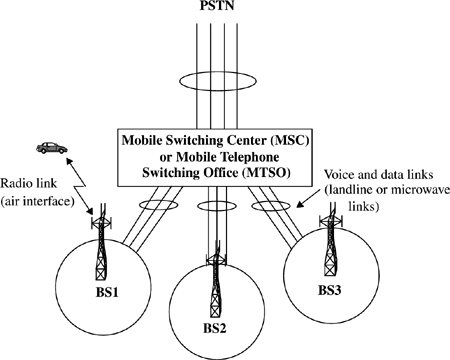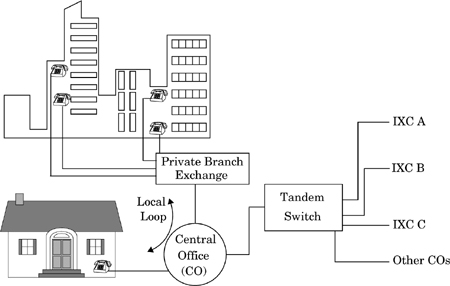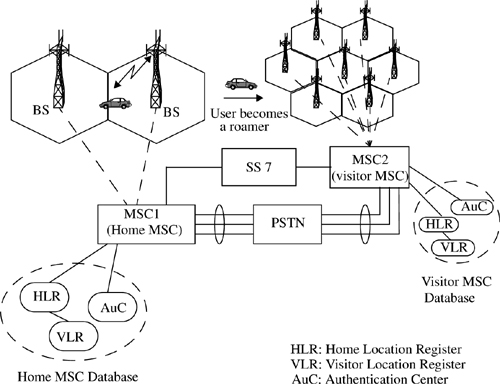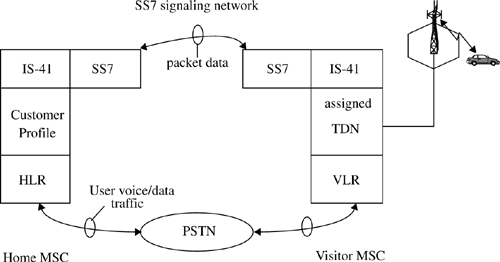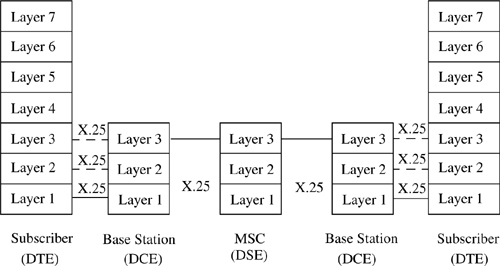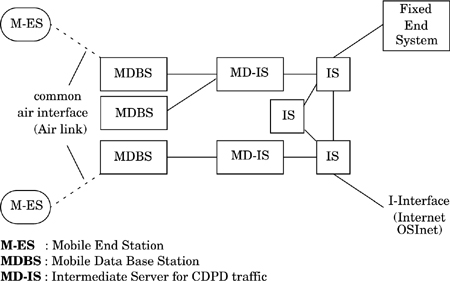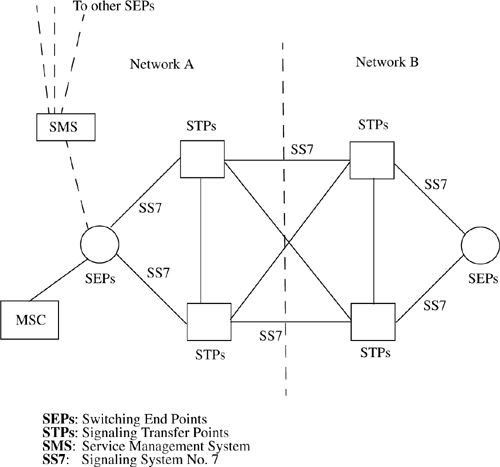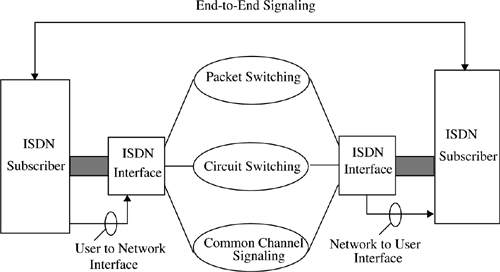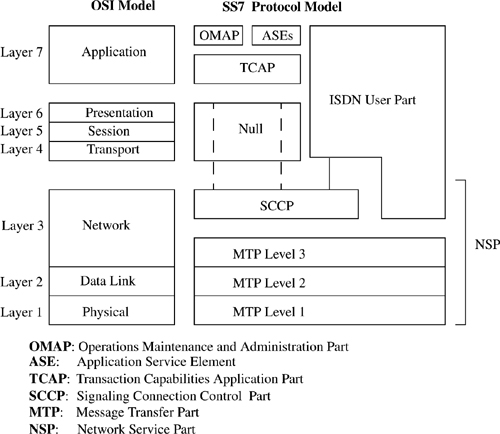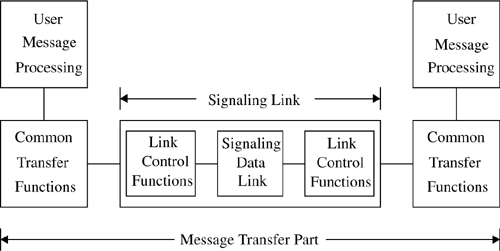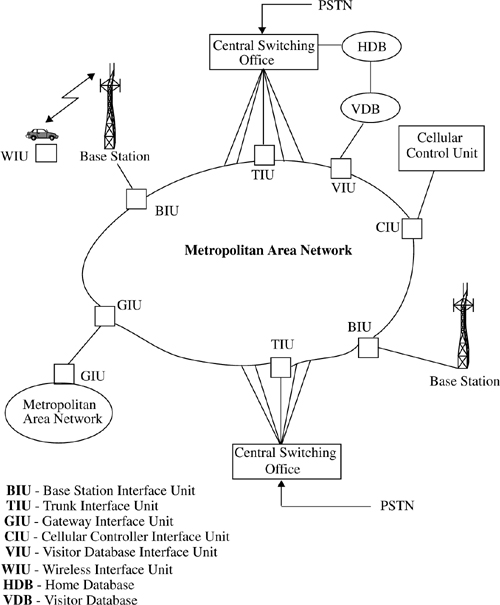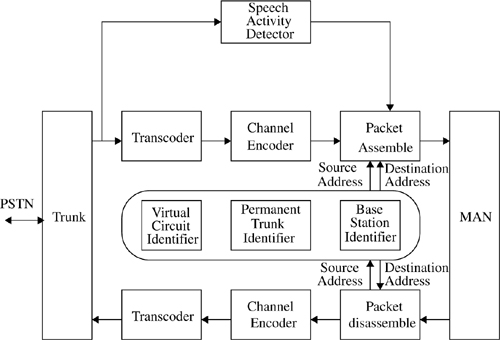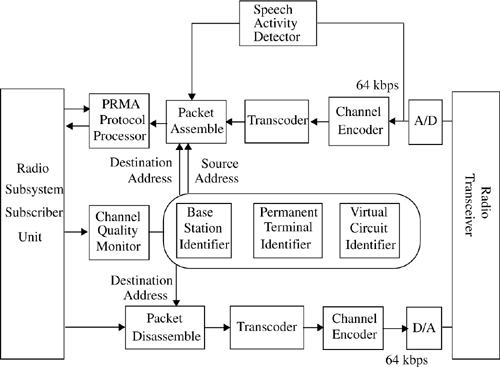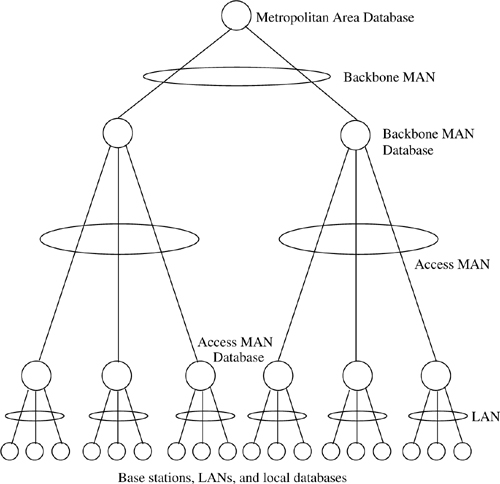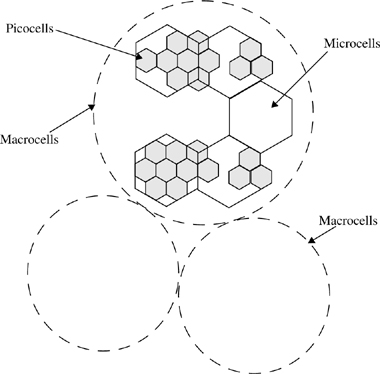The demand for ubiquitous personal communications is driving the development of new networking techniques that accommodate mobile voice and data users who move throughout buildings, cities, or countries. Consider the cellular telephone system shown in Figure 10.1. The cellular telephone system is responsible for providing coverage throughout a particular territory, called a coverage region or market. The interconnection of many such systems defines a wireless network capable of providing service to mobile users throughout a country or continent.
To provide wireless communications within a particular geographic region (a city, for example), an integrated network of base stations must be deployed to provide sufficient radio coverage to all mobile users. The base stations, in turn, must be connected to a central hub called the mobile switching center (MSC). The MSC provides connectivity between the public switched telephone network (PSTN) and the numerous base stations, and ultimately between all of the wireless subscribers in a system. The PSTN forms the global telecommunications grid which connects conventional (landline) telephone switching centers (called central offices) with MSCs throughout the world.
Figure 10.1 illustrates a typical cellular system of the early 1990s, but there is currently a major thrust to develop new transport architectures for the wireless end-users. For example, PCS may be distributed over the existing cable television plant to neighborhoods or city blocks, where microcells are used to provide local wireless coverage. Fiber optic transport architectures are also being used to connect radio ports, base stations, and MSCs.
To connect mobile subscribers to the base stations, radio links are established using a carefully defined communication protocol called common air interface (CAI) which in essence is a precisely defined handshake communication protocol. The common air interface specifies exactly how mobile subscribers and base stations communicate over radio frequencies and also defines the control channel signaling methods. The CAI must provide a great deal of channel reliability to ensure that data is properly sent and received between the mobile and the base station, and as such specifies speech and channel coding.
At the base station, the air interface portion (i.e., signaling and synchronization data) of the mobile transmission is discarded, and the remaining voice traffic is passed along to the MSC on fixed networks. While each base station may handle on the order of 50 simultaneous calls, a typical MSC is responsible for connecting as many as 100 base stations to the PSTN (as many as 5,000 calls at one time), so the connection between the MSC and the PSTN requires substantial capacity at any instant of time. It becomes clear that networking strategies and standards may vary widely depending on whether a single voice circuit or an entire metropolitan population is served.
Unfortunately, the term network may be used to describe a wide range of voice or data connections, from the case of a single mobile user to the base station, to the connection of a large MSC to the PSTN. This broad network definition presents a challenge in describing the large number of strategies and standards used in networking, and it is not feasible to cover all aspects of wireless networking in this chapter. However, the basic concepts and standards used in today’s wireless networks are covered in a manner which first addresses the mobile-to-base link, followed by the connection of the base station to the MSC, the connection of the MSC to the PSTN, and the interconnection of MSCs throughout the world.
Transfer of information in the public switched telephone network (PSTN) takes place over landline trunked lines (called trunks) comprised of fiber optic cables, copper cables, microwave links, and satellite links. The network configurations in the PSTN are virtually static, since the network connections may only be changed when a subscriber changes residence and requires reprogramming at the local central office (CO) of the subscriber. Wireless networks, on the other hand, are highly dynamic, with the network configuration being rearranged every time a subscriber moves into the coverage region of a different base station or a new market. While fixed networks are difficult to change, wireless networks must reconfigure themselves for users within small intervals of time (on the order of seconds) to provide roaming and imperceptible handoffs between calls as a mobile moves about. The available channel bandwidth for fixed networks can be increased by installing high capacity cables (fiberoptic or coaxial cable), whereas wireless networks are constrained by the meager RF cellular bandwidth provided for each user.
The PSTN is a highly integrated communications network that connects over 70% of the world’s inhabitants. In early 2001, the International Telecommunications Union estimated that there were 1 billion public landline telephone numbers, as compared to 600 million cellular telephone numbers. While landline telephones are being added at a 3% rate, wireless subscriptions are growing at greater than a 40% rate. Every telephone in the world is given calling access over the PSTN.
Each country is responsible for the regulation of the PSTN within its borders. Over time, some government telephone systems have become privatized by corporations which provide local and long distance service for profit.
In the PSTN, each city or a geographic grouping of towns is called a local access and transport area (LATA). Surrounding LATAs are connected by a company called a local exchange carrier (LEC). A LEC is a company that provides intralata telephone service, and may be a local telephone company, or may be a telephone company that is regional in scope.
A long distance telephone company collects toll fees to provide connections between different LATAs over its long distance network. These companies are referred to as interexchange carriers (IXCs), and own and operate large fiber optic and microwave radio networks which are connected to LECs throughout a country or continent.
In the United States, the 1984 divestiture decree (called the modified final judgement or MFJ) resulted in the break-up of AT&T (once the main local and long distance company in the US) into seven major Bell Operating Companies (BOCs), each with its own service region. By US Government mandate, AT&T is forbidden to provide local service within each BOC region (see Figure 10.2), although it is allowed to provide long distance service between LATAs within a BOC region and interexchange service between each region. BOCs are forbidden to provide interLATA calling within their own region and are also forbidden to provide the long distance interexchange service. In the US, there are about 2000 telephone companies, although the Bell Operating Companies (BOCs) are the most widely known (see Figure 10.2).
Figure 10.3 is a simplified illustration of a local telephone network, called a local exchange. Each local exchange consists of a central office (CO) which provides PSTN connection to the customer premises equipment (CPE) which may be an individual phone at a residence or a private branch exchange (PBX) at a place of business. The CO may handle as many as a million telephone connections. The CO is connected to a tandem switch which in turn connects the local exchange to the PSTN. The tandem switch physically connects the local telephone network to the point of presence (POP) of trunked long distance lines provided by one or more IXCs [Pec92]. Sometimes IXCs connect directly to the CO switch to avoid local transport charges levied by the LEC.
Figure 10.3 also shows how a PBX may be used to provide telephone connections throughout a building or campus. A PBX allows an organization or entity to provide internal calling and other in-building services (which do not involve the LEC), as well as private networking between other organizational sites (through leased lines from LEC and IXC providers), in addition to conventional local and long distance services which pass through the CO. Telephone connections within a PBX are maintained by the private owner, whereas connection of the PBX to the CO is provided and maintained by the LEC.
As compared with the local, fixed telephone network, where all end-users are static, a wireless communications system is extremely complex. First, the wireless network requires an air interface between base stations and subscribers to provide telephone grade communications under a wide range of propagation conditions and for any possible user location. To assure adequate area coverage, the deployment of many (sometimes hundreds) of base stations throughout a market is necessary, and each of these base stations must be connected to the MSC. Furthermore, the MSC must eventually provide connection for each of the mobile users to the PSTN. This requires simultaneous connections to the LEC, one or more IXCs, and to other MSCs via a separate cellular signaling network.
Historically, the demand for wireless communications has consistently exceeded the capacity of available technology, and this is most evident in the design of MSCs. While a central office (CO) telephone switch may handle up to a million landline subscribers simultaneously, the most sophisticated MSCs of the mid 1990s are only able to handle 100,000 to 200,000 simultaneous cellular telephone subscribers.
A problem unique to wireless networks is the extremely hostile and random nature of the radio channel, and since users may request service from any physical location while traveling over a wide range of velocities, the MSC is forced to switch calls imperceptibly between base stations throughout the system. The radio spectrum available for this purpose is limited, thus wireless systems are constrained to operate in a fixed bandwidth to support an increasing number of users over time. Spectrally efficient modulation techniques, frequency reuse techniques, and geographically distributed radio access points are vital components of wireless networks. As wireless systems grow, the necessary addition of base stations increases the switching burden of the MSC. Because the geographical location of a mobile user changes constantly, extra overhead is needed by all aspects of a wireless network, particularly at the MSC, to ensure seamless communications, regardless of the location of the user.
Throughout the world, first generation wireless systems (analog cellular and cordless telephones) were deployed in the early and mid 1980s. As first generation wireless systems were being introduced, revolutionary advances were being made in the design of the PSTN by landline telephone companies. Until the mid 1980s, most analog landline telephone links throughout the world sent signaling information along the same trunked lines as voice traffic. That is, a single physical connection was used to handle both signaling traffic (dialed digits and telephone ringing commands) and voice traffic for each user. The overhead required in the PSTN to handle signaling data on the same trunks as voice traffic was inefficient, since this required a voice trunk to be dedicated during periods of time when no voice traffic was actually being carried. Put simply, valuable LEC and long distance voice trunks were being used to provide low, data rate signaling information that a parallel signaling channel could have provided with much less bandwidth.
The advantage of a separate but parallel signaling channel allows the voice trunks to be used strictly for revenue-generating voice traffic, and supports many more users on each trunked line. Thus, during the mid 1980s, the PSTN was transformed into two parallel networks—one dedicated to user traffic, and one dedicated to call signaling traffic. This technique is called common channel signaling.
Common channel signaling is used in all modern telephone networks. Most recently, dedicated signaling channels have been used by cellular MSCs to provide global signaling interconnection, thereby enabling MSCs throughout the world to pass subscriber information. In many of today’s cellular telephone systems, voice traffic is carried on the PSTN while signaling information for each call is carried on a separate signaling channel. Access to the signaling network is usually provided by IXCs for a negotiated fee. In North America, the cellular telephone signaling network uses No. 7 Signaling System (SS7), and each MSC uses the IS-41 protocol to communicate with other MSCs on the continent [Rap95].
In first generation cellular systems, common signaling channels were not used, and signaling data was sent on the same trunked channel as the voice user. In second generation wireless systems, however, the air interfaces have been designed to provide parallel user and signaling channels for each mobile, so that each mobile receives the same features and services as fixed wireline telephones in the PSTN.
First generation cellular and cordless telephone networks are based on analog technology. All first generation cellular systems use FM modulation, and cordless telephones use a single base station to communicate with a single portable terminal. A typical example of a first generation cellular telephone system is the Advanced Mobile Phone Services (AMPS) system used in the United States (see Chapter 11). Basically, all first generation systems use the transport architecture shown in Figure 10.4.
Figure 10.5 shows a diagram of a first generation cellular radio network, which includes the mobile terminals, the base stations, and MSCs. In first generation cellular networks, the system control for each market resides in the MSC, which maintains all mobile related information and controls each mobile handoff. The MSC also performs all of the network management functions, such as call handling and processing, billing, and fraud detection within the market. The MSC is interconnected with the PSTN via landline trunked lines (trunks) and a tandem switch. MSCs also are connected with other MSCs via dedicated signaling channels (see Figure 10.6) for exchange of location, validation, and call signaling information.
Notice that in Figure 10.6, the PSTN is a separate network from the SS7 signaling network. In modern cellular telephone systems, long distance voice traffic is carried on the PSTN, but the signaling information used to provide call set-up and to inform MSCs about a particular user is carried on the SS7 network.
First generation wireless systems provide analog speech and inefficient, low-rate, data transmission between the base station and the mobile user. However, the speech signals are usually digitized using a standard, time division multiplex format for transmission between the base station and the MSC and are always digitized for distribution from the MSC to the PSTN.
The global cellular network is required to keep track of all mobile users that are registered in all markets throughout the network, so that it is possible to forward incoming calls to roaming users at any location throughout the world. When a mobile user’s phone is activated but is not involved in a call, it monitors the strongest control channel in the vicinity. When the user roams into a new market covered by a different service provider, the wireless network must register the user in the new area and cancel its registration with the previous service provider so that calls may be routed to the roamer as it moves through the coverage areas of different MSCs.
Until the early 1990s, US cellular customers that roamed between different cellular systems had to register manually each time they entered a new market during long distance travel. This required the user to call an operator to request registration. In the early 1990s, US cellular carriers implemented the network protocol standard IS-41 to allow different cellular systems to automatically accommodate subscribers who roam into their coverage region. This is called interoperator roaming. IS-41 allows MSCs of different service providers to pass information about their subscribers to other MSCs on demand.
IS-41 relies on a feature of AMPS called autonomous registration. Autonomous registration is a process by which a mobile notifies a serving MSC of its presence and location. The mobile accomplishes this by periodically keying up and transmitting its identity information, which allows the MSC to constantly update its customer list. The registration command is sent in the overhead message of each control channel at five or ten minute intervals, and includes a timer value which each mobile uses to determine the precise time at which it should respond to the serving base station with a registration transmission. Each mobile reports its MIN and ESN during the brief registration transmission so that the MSC can validate and update the customer list within the market. The MSC is able to distinguish home users from roaming users based on the MIN of each active user, and maintains a real-time user list in the home location register (HLR) and visitor location register (VLR) as shown in Figure 10.5. IS-41 allows the MSCs of neighboring systems to automatically handle the registration and location validation of roamers so that users no longer need to manually register as they travel. The visited system creates a VLR record for each new roamer and notifies the home system via IS-41 so it can update its own HLR.
Second generation wireless systems employ digital modulation and advanced call processing capabilities. Examples of second generation wireless systems include the Global System for Mobile (GSM), the TDMA and CDMA US digital standards (the Telecommunications Industry Association IS-136 and IS-95 standards), Second Generation Cordless Telephone (CT2), the British standard for cordless telephony, the Personal Access Communications System (PACS) local loop standard, and Digital European Cordless Telephone (DECT), which is the European standard for cordless and office telephony. There are many other second generation systems, as described in Chapter 11.
Second generation wireless networks have introduced new network architectures that have reduced the computational burden of the MSC. As shown in Chapter 11, GSM introduced the concept of a base station controller (BSC), which is inserted between several base stations and the MSC. In PACS/WACS, the BSC is called a radio port control unit. This architectural change has allowed the data interface between the base station controller and the MSC to be standardized, thereby allowing carriers to use different manufacturers for MSC and BSC components. This trend in standardization and interoperability is new to second generation wireless networks. Eventually, wireless network components, such as the MSC and BSC, will be available as off-the-shelf components, much like their wireline telephone counterparts.
All second generation systems use digital voice coding and digital modulation. The systems employ dedicated control channels (common channel signaling—see Section 10.7) within the air interface for simultaneously exchanging voice and control information between the subscriber, the base station, and the MSC while a call is in progress. Second generation systems also provide dedicated voice and signaling trunks between MSCs, and between each MSC and the PSTN.
In contrast to first generation systems, which were designed primarily for voice, second generation wireless networks have been specifically designed to provide paging, and other data services such as facsimile and high-data rate network access. The network controlling structure is more distributed in second generation wireless systems, since mobile stations assume greater control functions. In second generation wireless networks, the handoff process is mobile-controlled and is known as mobile assisted handoff (MAHO—explained in Chapter 3). The mobile units in these networks perform several other functions not performed by first generation subscriber units, such as received power reporting, adjacent base station scanning, data encoding, and encryption.
DECT is an example of a second generation cordless telephone standard which allows each cordless phone to communicate with any of a number of base stations, by automatically selecting the base station with the greatest signal level. In DECT, the base stations have greater control in terms of switching, signaling, and controlling handoffs. In general, second generation systems have been designed to reduce the computational and switching burden at the base station or MSC, while providing more flexibility in the channel allocation scheme so that systems may be deployed rapidly and in a less coordinated manner.
As discussed in Chapter 2, third generation wireless systems will evolve from mature second generation systems. The aim of third generation wireless networks is to provide a single set of standards that can meet a wide range of wireless applications and provide universal access throughout the world. In third generation wireless systems, the distinctions between cordless telephones and cellular telephones will disappear, and a universal personal communicator (a personal handset) will provide access to a variety of voice, data, and video communication services.
Third generation systems will use the Broadband Integrated Services Digital Network (B-ISDN) (described in Section 10.8) to provide access to information networks, such as the Internet and other public and private databases. Third generation networks will carry many types of information (voice, data, and video), will operate in varied regions (dense or sparsely populated regions), and will serve both stationary users and vehicular users traveling at high speeds. Packet radio communications will likely be used to distribute network control while providing a reliable information transfer [Goo90].
The terms 3G Personal Communication System (PCS) and 3G Personal Communication Network (PCN) are used to imply emerging third generation wireless systems for hand-held devices. Other names for PCS include Future Public Land Mobile Telecommunication Systems (FPLMTS) for worldwide use which has more recently been called International Mobile Telecommunication (IMT-2000), and Universal Mobile Telecommunication System (UMTS) for advanced mobile personal services in Europe.
Wireless networks rely heavily on landline connections. For example, the MSC connects to the PSTN and SS7 networks using fiberoptic or copper cable or microwave links. Base stations within a cellular system are connected to the MSC using line-of-sight (LOS) microwave links, or copper or fiber optic cables. These connections require high data rate serial transmission schemes in order to reduce the number of physical circuits between two points of connection.
Several standard digital signaling (DS) formats form a transmission hierarchy that allows high data rate digital networks which carry a large number of voice channels to be interconnected throughout the world. These DS formats use time division multiplexing (TDM). The most basic DS format in the US is called DS-0, which represents one duplex voice channel which is digitized into a 64 kbps binary PCM format. The next DS format is DS-1, which represents twenty-four full duplex DS-0 voice channels that are time division multiplexed into a 1.544 Mbps data stream (8 kbps is used for control purposes). Related to digital transmission hierarchy is the T(N) designation, which is used to denote transmission line compatibility for a particular DS format. DS-1 signaling is used for a T1 trunk, which is a popular point-to-point network signaling format used to connect base stations to the MSC. T1 trunks digitize and distribute the twenty-four voice channels onto a simple four-wire full duplex circuit. In Europe, CEPT (Conference Européene des Administration des Postes et des Télécommunications/European Conference of Postal and Telecommunications Administrations) has defined a similar digital hierarchy. Level 0 represents a duplex 64 kbps voice channel, whereas level 1 concentrates thirty channels into a 2.048 Mbps TDM data stream. Most of the world’s PTTs have adopted the European hierarchy. Table 10.1 illustrates the digital hierarchy for North America and Europe [Pec92].
Table 10.1. Digital Transmission Hierarchy
Signal Level | Digital Bit Rate | Equivalent Voice Circuits | Carrier System |
|---|---|---|---|
North America and Japan | |||
DS-0 | 64.0 kbps | 1 | |
DS-1 | 1.544 Mbps | 24 | T-1 |
DS-1C | 3.152 Mbps | 48 | T-1C |
DS-2 | 6.312 Mbps | 96 | T-2 |
DS-3 | 44.736 Mbps | 672 | T-3 |
DS-4 | 274.176 Mbps | 4032 | T-4 |
CEPT (Europe and most other PTTs) | |||
0 | 64.0 kbps | 1 | |
1 | 2.048 Mbps | 30 | E-1 |
2 | 8.448 Mbps | 120 | E-1C |
3 | 34.368 Mbps | 480 | E-2 |
4 | 139.264 Mbps | 1920 | E-3 |
5 | 565.148 Mbps | 7680 | E-4 |
Typically, coaxial or fiber optic cable or wideband microwave links are used to transmit data rates in excess of 10 Mbps, whereas inexpensive wire (twisted pair) or coaxial cable may be used for slower data transfer. When connecting base stations to a MSC, or distributing trunked voice channels throughout a wireless network, T1 (DS1) or level 1 links are most commonly used and utilize common-twisted pair wiring. DS-3 and higher rate circuits are used to connect MSCs and COs to the PSTN.
The amount of traffic capacity required in a wireless network is highly dependent upon the type of traffic carried. For example, a subscriber’s telephone call (voice traffic) requires dedicated network access to provide real-time communications, whereas control and signaling traffic may be bursty in nature and may be able to share network resources with other bursty users. Alternatively, some traffic may have an urgent delivery schedule while some may have no need to be sent in real-time. The type of traffic carried by a network determines the routing services, protocols, and call handling techniques which must be employed.
Two general routing services are provided by networks. These are connection-oriented services (virtual circuit routing), and connectionless services (datagram services). In connection-oriented routing, the communications path between the message source and destination is fixed for the entire duration of the message, and a call set-up procedure is required to dedicate network resources to both the called and calling parties. Since the path through the network is fixed, the traffic in connection-oriented routing arrives at the receiver in the exact order it was transmitted. A connection-oriented service relies heavily on error control coding to provide data protection in case the network connection becomes noisy. If coding is not sufficient to protect the traffic, the call is broken, and the entire message must be retransmitted from the beginning.
Connectionless routing, on the other hand, does not establish a firm connection for the traffic, and instead relies on packet-based transmissions. Several packets form a message, and each individual packet in a connectionless service is routed separately. Successive packets within the same message might travel completely different routes and encounter widely varying delays throughout the network. Packets sent using connectionless routing do not necessarily arrive in the order of transmission and must to be reordered at the receiver. Because packets take different routes in a connectionless service, some packets may be lost due to network or link failure, however others may get through with sufficient redundancy to enable the entire message to be recreated at the receiver. Thus, connectionless routing often avoids having to retransmit an entire message, but requires more overhead information for each packet. Typical packet overhead information includes the packet source address, the destination address, the routing information, and information needed to properly order packets at the receiver. In a connectionless service, a call set-up procedure is not required at the beginning of a call, and each message burst is treated independently by the network.
First generation cellular systems provide connection-oriented services for each voice user. Voice channels are dedicated for users at a serving base station, and network resources are dedicated to the voice traffic upon initiation of a call. That is, the MSC dedicates a voice channel connection between the base station and the PSTN for the duration of a cellular telephone call. Furthermore, a call initiation sequence is required to connect the called and calling parties on a cellular system. When used in conjunction with radio channels, connection-oriented services are provided by a technique called circuit switching, since a physical radio channel is dedicated (“switched in to use”) for two-way traffic between the mobile user and the MSC, and the PSTN dedicates a voice circuit between the MSC and the end-user. As calls are initiated and completed, different radio circuits and dedicated PSTN voice circuits are switched in and out to handle the traffic.
Circuit switching establishes a dedicated connection (a radio channel between the base and mobile, and a dedicated phone line between the MSC and the PSTN) for the entire duration of a call. Despite the fact that a mobile user may hand off to different base stations, there is always a dedicated radio channel to provide service to the user, and the MSC dedicates a fixed, full duplex phone connection to the PSTN.
Wireless data networks are not well supported by circuit switching, due to their short, bursty transmissions which are often followed by periods of inactivity. Often, the time required to establish a circuit exceeds the duration of the data transmission. Circuit switching is best suited for dedicated voice-only traffic, or for instances where data is continuously sent over long periods of time.
Connectionless services exploit the fact that dedicated resources are not required for message transmission. Packet switching (also called virtual switching) is the most common technique used to implement connectionless services and allows a large number of data users to remain virtually connected to the same physical channel in the network. Since all users may access the network randomly and at will, call set-up procedures are not needed to dedicate specific circuits when a particular user needs to send data. Packet switching breaks each message into smaller units for transmission and recovery [Ber92], [DeR94]. When a message is broken into packets, a certain amount of control information is added to each packet to provide source and destination identification, as well as error recovery provisions.
Figure 10.7 illustrates the sequential format of a packet transmission. The packet consists of header information, the user data, and a trailer. The header specifies the beginning of a new packet and contains the source address, destination address, packet sequence number, and other routing and billing information. The user data contains information which is generally protected with error control coding. The trailer contains a cyclic redundancy checksum which is used for error detection at the receiver.
Figure 10.8 shows the structure of a transmitted packet, which typically consists of five fields: the flag bits, the address field, the control field, the information field, and the frame check sequence field. The flag bits are specific (or reserved) bit sequences that indicate the beginning and end of each packet. The address field contains the source and the destination address for transmitting messages and for receiving acknowledgments. The control field defines functions such as transfer of acknowledgments, automatic repeat requests (ARQs), and packet sequencing. The information field contains the user data and may have variable length. The final field is the frame check sequence field or the CRC (Cyclic Redundancy Check) that is used for error detection.
In contrast to circuit switching, packet switching (also called packet radio when used over a wireless link) provides excellent channel efficiency for bursty data transmissions of short length. An advantage of packet-switched data is that the channel is utilized only when sending or receiving bursts of information. This benefit is valuable for the case of mobile services where the available bandwidth is limited. The packet radio approach supports intelligent protocols for data flow control and retransmission, which can provide highly reliable transfer in degraded channel conditions. X.25 is a widely used packet radio protocol that defines a data interface for packet switching [Ber92], [Tan81].
X.25 was developed by CCITT (now ITU-T) to provide standard connectionless network access (packet switching) protocols for the three lowest layers (layers 1, 2, and 3) of the open systems interconnection (OSI) model (see Figure 10.14 for the OSI layer hierarchy). The X.25 protocols provide a standard network interface between originating and terminating subscriber equipment (called data terminal equipment or DTE), the base stations (called data circuit-terminating equipment or DCE), and the MSC (called the data switching exchange or DSE). The X.25 protocols are used in many packet radio air-interfaces, as well as in fixed networks [Ber92], [Tan81].
Figure 10.9 shows the hierarchy of X.25 protocols in the OSI model. The Layer 1 protocol deals with the electrical, mechanical, procedural, and functional interface between the subscriber (DTE), and the base station (DCE). The Layer 2 protocol defines the data link on the common air-interface between the subscriber and the base station. Layer 3 provides connection between the base station and the MSC, and is called the packet layer protocol. A packet assembler disassembler (PAD) is used at Layer 3 to connect networks using the X.25 interface with devices that are not equipped with a standard X.25 interface.
The X.25 protocol does not specify particular data rates or how packet-switched networks are implemented. Rather, X.25 provides a series of standard functions and formats which give structure to the design of software that is used to provide packet data on a generic connectionless network.
As discussed in Section 10.5, circuit switching is inefficient for dedicated mobile data services such as facsimile (fax), electronic mail (e-mail), and short messaging. First generation cellular systems that provide data communications using circuit switching have difficulty passing modem signals through the audio filters of receivers designed for analog, FM, common air-interfaces. Inevitably, voice filtering must be deactivated when data is transmitted over first generation cellular networks, and a dedicated data link must be established over the common air-interface. The demand for packet data services has, until recently, been significantly less than the demand for voice services, and first generation subscriber equipment design has focused almost solely on voice-only cellular communications. However, in 1993, the US cellular industry developed the cellular digital packet data (CDPD) standard to coexist with the conventional voice-only cellular system. In the 1980s, two other data-only mobile services called ARDIS and RAM Mobile Data (RMD) were developed to provide packet radio connectivity throughout a network.
CDPD is a data service for first and second generation US cellular systems and uses a full 30 kHz AMPS channel on a shared basis [CTI93], [DeR94]. CDPD provides mobile packet data connectivity to existing data networks and other cellular systems without any additional bandwidth requirements. It also capitalizes on the unused air time which occurs between successive radio channel assignments by the MSC (it is estimated that for 30% of the time, a particular cellular radio channel is unused, so packet data may be transmitted until that channel is selected by the MSC to provide a voice circuit).
CDPD directly overlays with existing cellular infrastructure and uses existing base station equipment, making it simple and inexpensive to install. Furthermore, CDPD does not use the MSC, but rather has its own traffic routing capabilities. CDPD occupies voice channels purely on a secondary, noninterfering basis, and packet channels are dynamically assigned (hopped) to different cellular voice channels as they become vacant, so the CDPD radio channel varies with time.
As with conventional, first generation AMPS, each CDPD channel is duplex in nature. The forward channel serves as a beacon and transmits data from the PSTN side of the network, while the reverse channel links all mobile users to the CDPD network and serves as the access channel for each subscriber. Collisions may result when many mobile users attempt to access the network simultaneously. Each CDPD simplex link occupies a 30 kHz RF channel, and data is sent at 19,200 bps. Since CDPD is packet-switched, a large number of modems are able to access the same channel on an as needed, packet-by-packet basis. CDPD supports broadcast, dispatch, electronic mail, and field monitoring applications. GMSK BT = 0.5 modulation is used so that existing analog FM cellular receivers can easily detect the CDPD format without redesign.
CDPD transmissions are carried out using fixed-length blocks. User data is protected using a Reed–Solomon (63,47) block code with 6-bit symbols. For each packet, 282 user bits are coded into 378 bit blocks, which provide correction for up to eight symbols.
Two lower layer protocols are used in CDPD. The mobile data link protocol (MDLP) is used to convey information between data link layer entities (layer 2 devices) across the CDPD air interface. The MDLP provides logical data link connections on a radio channel by using an address contained in each packet frame. The MDLP also provides sequence control to maintain the sequential order of frames across a data link connection, as well as error detection and flow control. The radio resource management protocol (RRMP) is a higher, layer 3 protocol used to manage the radio channel resources of the CDPD system and enables an M-ES to find and utilize a duplex radio channel without interfering with standard voice services. The RRMP handles base-station identification and configuration messages for all M-ES stations, and provides information that the M-ES can use to determine usable CDPD channels without knowledge of the history of channel usage. The RRMP also handles channel hopping commands, cell handoffs, and M-ES change of power commands. CDPD version 1.0 uses the X.25 wide area network (WAN) subprofile and frame relay capabilities for internal subnetworks.
Table 10.2 lists the link layer characteristics for CDPD. Figure 10.10 illustrates a typical CDPD network. Note that the subscribers (the mobile end system, or M-ES) are able to connect through the mobile data base stations (MDBS) to the Internet via intermediate systems (MD-IS), which act as servers and routers for the subscribers. In this way, mobile users are able to connect to the Internet or the PSTN. Through the I-interface, CDPD can carry either Internet protocol (IP) or OSI connectionless protocol (CLNP) traffic.
Table 10.2. Link Layer Characteristics for CDPD
Protocols | MDLP, RRMP, X.25 |
|---|---|
Channel Data Rate (bps) | 19,200 |
Channel Bandwidth (kHz) | 30 |
Spectrum Efficiency (b/Hz) | 0.64 |
Random Error Strategy | cover with burst protect |
Burst Error Strategy | RS 63,47 (6 bits per symbol) |
Fading Performance | withstands 2.2 ms fade |
Channel Access | slotted DSMA/CD |
Advance Radio Data Information Systems (ARDIS) is a private network service provided by Motorola and IBM and is based on MDC 4800 and RD-LAP (Radio Data Link Access Procedure) protocols developed at Motorola [DeR94]. ARDIS provides 800 MHz two-way mobile data communications for short-length radio messages in urban and in-building environments, and for users traveling at low speeds. Short ARDIS messages have low retry rates but high packet overhead, while long messages spread the overhead over the length of the packet but have a higher retry rate. ARDIS has been deployed to provide excellent in-building penetration, and large-scale spatial antenna diversity is used to receive messages from mobile users. When a mobile sends a packet, many base stations which are tuned to the transmission frequency attempt to detect and decode the transmission, in order to provide diversity reception for the case when multiple mobiles contend for the reverse link. In this manner, ARDIS base stations are able to insure detection of simultaneous transmissions, as long as the users are sufficiently separated in space. Table 10.3 lists some characteristics for ARDIS.
Table 10.3. Channel Characteristics for ARDIS
Protocol | MDC 4800 | RD-LAP |
|---|---|---|
Speed (bps) | 4800 | 19,200 |
Channel Bandwidth (kHz) | 25 | 25 |
Spectrum Efficiency (b/Hz) | 0.19 | 0.77 |
Random Error Strategy | convolutional 1/2, k = 7 | trellis coded modulation, rate = 3/4 |
Burst Error Strategy | interleave 16 bits | interleave 32 bits |
Fading Performance | withstands 3.3 ms fade | withstands 1.7 ms fade |
Channel Access | CSMA nonpersistent | slot CSMA |
RAM Mobile Data (RMD) is a public, two-way data service based upon the Mobitex protocol developed by Ericsson. RAM provides street level coverage for short and long messages for users moving in an urban environment. RAM has capability for voice and data transmission, but has been designed primarily for data and facsimile. Fax messages are transmitted as normal text to a gateway processor, which then converts the radio message to an appropriate format by merging it with a background page. Thus, the packet-switched wireless transmission consists of a normal length message instead of a much larger fax image, even though the end-user receives what appears to be a standard fax [DeR94]. Table 10.4 lists some characteristics of the RAM mobile data service.
Common channel signaling (CCS) is a digital communications technique that provides simultaneous transmission of user data, signaling data, and other related traffic throughout a network. This is accomplished by using out-of-band signaling channels which logically separate the network data from the user information (voice or data) on the same channel. For second generation wireless communications systems, CCS is used to pass user data and control/supervisory signals between the subscriber and the base station, between the base station and the MSC, and between MSCs. Even though the concept of CCS implies dedicated, parallel channels, it is implemented in a TDM format for serial data transmissions.
Before the introduction of CCS in the 1980s, signaling traffic between the MSC and a subscriber was carried in the same band as the end-user’s audio. The network control data passed between MSCs in the PSTN was also carried in-band, requiring that network information be carried within the same channel as the subscriber’s voice traffic throughout the PSTN. This technique, called in-band signaling, reduced the capacity of the PSTN, since the network signaling data rates were greatly constrained by the limitations of the carried voice channels, and the PSTN was forced to sequentially (not simultaneously) handle signaling and user data for each call.
CCS is an out-of-band signaling technique which allows much faster communications between two nodes within the PSTN. Instead of being constrained to signaling data rates which are on the order of audio frequencies, CCS supports signaling data rates from 56 kbps to many megabits per second. Thus, network signaling data is carried in a seemingly parallel, out-of-band, signaling channel while only user data is carried on the PSTN. CCS provides a substantial increase in the number of users which are served by trunked PSTN lines, but requires that a dedicated portion of the trunk time be used to provide a signaling channel used for network traffic. In first generation cellular systems, the SS7 family of protocols, as defined by the Integrated System Digital Network (ISDN) are used to provide CCS.
Since network signaling traffic is bursty and of short duration, the signaling channel may be operated in a connectionless fashion where packet data transfer techniques are efficiently used. CCS generally uses variable length packet sizes and a layered protocol structure. The expense of a parallel signaling channel is minor compared to the capacity improvement offered by CCS throughout the PSTN, and often the same physical network connection (i.e., a fiber optic cable) carries both the user traffic and the network signaling data.
As more users subscribe to wireless services, backbone networks that link MSCs together will rely more heavily on network signaling to preserve message integrity, to provide end-to-end connectivity for each mobile user, and to maintain a robust network that can recover from failures. CCS forms the foundation of network control and management functions in second and third generation networks. Out-of-band signaling networks which connect MSCs throughout the world enable the entire wireless network to update and keep track of specific mobile users, wherever they happen to be. Figure 10.6 illustrates how an MSC is connected to both the PSTN and the signaling network.
As shown in Figure 10.11, the CCS network architecture is composed of geographically distributed central switching offices, each with embedded switching end points (SEPs), signaling transfer points (STPs), a service management system (SMS), and a database service management system (DBAS) [Mod92], [Boy90], [Mar90].
The MSC provides subscriber access to the PSTN via the SEP. The SEP implements a stored-program-control switching system known as the service control point (SCP) that uses CCS to set up calls and to access a network database. The SCP instructs the SEP to create billing records based on the call information recorded by the SCP.
The STP controls the switching of messages between nodes in the CCS network. For higher reliability of transmission (redundancy), SEPs are required to be connected to the SS7 network (described in Section 10.8) via at least two STPs. This combination of two STPs in parallel is known as a mated pair, and provides connectivity to the network in the event one STP fails.
The SMS contains all subscriber records, and also houses toll-free databases which may be accessed by the subscribers. The DBAS is the administrative database that maintains service records and investigates fraud throughout the network. The SMS and DBAS work in tandem to provide a wide range of customer and network provider services, based on SS7.
Integrated Services Digital Network (ISDN) is a complete network framework designed around the concept of common channel signaling. While telephone users throughout the world rely on the PSTN to carry conventional voice traffic, new end-user data and signaling services can be provided with a parallel, dedicated signaling network. ISDN defines the dedicated signaling network that has been created to complement the PSTN for more flexible and efficient network access and signaling [Mod92], and may be thought of as a parallel world-wide network for signaling traffic that can be used to either route voice traffic on the PSTN or to provide new data services between network nodes and the end-users.
ISDN provides two distinct kinds of signaling components to end-users in a telecommunications network. The first component supports traffic between the end-user and the network, and is called access signaling. Access signaling defines how end-users obtain access to the PSTN and the ISDN for communications or services, and is governed by a suite of protocols known as the Digital Subscriber Signaling System number 1 (DSS1). The second signaling component of ISDN is network signaling, and is governed by the SS7 suite of protocols [Mod92]. For wireless communications systems, the SS7 protocols within ISDN are critical to providing backbone network connectivity between MSCs throughout the world, as they provide network interfaces for common channel signaling traffic.
ISDN provides a complete digital interface between end-users over twisted pair telephone lines. The ISDN interface is divided into three different types of channels. Information bearing channels called bearer channels (B channels) are used exclusively for end-user traffic (voice, data, video). Out-of-band signaling channels, called data channels (D channels), are used to send signaling and control information across the interface to end-users. As shown in Figure 10.12, ISDN provides integrated end-user access to both circuit-switched and packet-switched networks with digital end-to-end connectivity.
ISDN end-users may select between two different interfaces, the basic rate interface (BRI) or the primary rate interface (PRI). The BRI is intended to serve small capacity terminals (such as single line telephones) while the PRI is intended for large capacity terminals (such as PBXs). The B channels support 64 kbps data for both the primary rate and the basic rate interfaces. The D channel supports 64 kbps for the primary rate and 16 kbps for the basic rate. The BRI provides two 64 kbps bearer channels and one 16 kbps signaling channel (2B+D), whereas the PRI provides twenty-three 64 kbps bearer channels and one 64 kbps signaling channel (23B+D) for North America and Japan. In Europe, the primary rate interface provides thirty basic information channels and one 64 kbps signaling channel (30B+D). The PRI service is designed to be carried by DS-1 or CEPT level 1 links (see Section 10.4).
For wireless service subscribers, an ISDN basic rate interface is provided in exactly the same manner as for a fixed terminal. To differentiate between wireless and fixed subscribers, the mobile BRI defines signaling data (D channels in the fixed network) as control channels (C channels in the mobile network), so that a wireless subscriber has 2B+C service.
Much like the digital signaling hierarchy described in Section 10.2, several ISDN circuits may be concatenated into high speed information channels (H channels). H channels are used by the ISDN backbone to provide efficient data transport of many users on a single physical connection, and may also be used by PRI end-users to allocate higher transmission rates on demand. ISDN defines H0 channels (384 kbps), H11 (1536 kbps), and H12 channels (1920 kbps) as shown in Table 10.5
With the proliferation of computer systems and video imaging, end-user applications are requiring much greater bandwidths than the standard 64 kbps B channel provided by ISDN. Recent work has defined ISDN interface standards that increase the end-user transmission bandwidth to several Mb/s. This emerging networking technique is known as broadband ISDN (B-ISDN) and is based on asynchronous transfer mode (ATM) technology which allows packet switching rates up to 2.4 Gbps and total switching capacities as high as 100 Gbps.
ATM is a packet switching and multiplexing technique which has been specifically designed to handle both voice users and packet data users in a single physical channel. ATM data rates vary from low traffic rates (64 kbps) over twisted pair to over 100 Mbps over fiberoptic cables for high traffic rates between network nodes. ATM supports bidirectional transfer of data packets of fixed length between two end points, while preserving the order of transmission. ATM data units, called cells, are routed based on header information in each unit (called a label) that identifies the cell as belonging to a specific ATM virtual connection. The label is determined upon virtual connection of a user, and remains the same throughout the transmission for a particular connection. The ATM header also includes data for congestion control, priority information for queuing of packets, and a priority which indicates which ATM packets can be dropped in case of congestion in the network.
Figure 10.13 shows the cell format of ATM. ATM cells (packets) have a fixed length of 53 bytes, consisting of 48 bytes of data and 5 bytes of header information. Fixed length packets result in simple implementation of fast packet switches, since packets arrive synchronously at the switch [Ber92]. A compromise was made in selecting the length of ATM cells to accommodate both voice and data users.
The SS7 signaling protocol is widely used for common channel signaling between interconnected networks (see Figure 10.11, for example). SS7 is used to interconnect most of the cellular MSCs throughout the US, and is the key factor in enabling autonomous registration and automated roaming in first generation cellular systems. The structure of SS7 signaling is discussed in greater detail in the text by Modarressi and Skoog [Mod92].
SS7 is an outgrowth of the out-of band signaling first developed by the CCITT under common channel signaling standard, CCS No. 6. Further work caused SS7 to evolve along the lines of the ISO-OSI seven layer network definition, where a highly layered structure (transparent from layer to layer) is used to provide network communications. Peer layers in the ISO model communicate with each other through a virtual (packet data) interface, and a hierarchical interface structure is established. A comparison of the OSI-7 network model and the SS7 protocol standard is given in Figure 10.14. The lowest three layers of the OSI model are handled in SS7 by the network service part (NSP) of the protocol, which in turn is made up of three message transfer parts (MTPs) and the signaling connection control part (SCCP) of the SS7 protocol.
The NSP provides ISDN nodes with a highly reliable and efficient means of exchanging signaling traffic using connectionless services. The SCCP in SS7 actually supports packet data network interconnections as well as connection-oriented networking to virtual circuit networks. The NSP allows network nodes to communicate throughout the world without concern for the application or context of the signaling traffic.
The function of the MTP is to ensure that signaling traffic can be transferred and delivered reliably between the end-users and the network. MTP is provided at three levels. Figure 10.15 shows the functionality of the various MTP levels that will be described.
Signaling data link functions (MTP Level 1) provide an interface to the actual physical channel over which communication takes place. Physical channels may include copper wire, twisted pair, fiber, mobile radio, or satellite links, and are transparent to the higher layers. CCITT recommends that MTP Level 1 use 64 kbps transmissions, whereas ANSI recommends 56 kbps. The minimum data rate provided for telephony control operations is 4.8 kbps [Mod92].
Signaling link functions (MTP Level 2) correspond to the second layer in the OSI reference model and provide a reliable link for the transfer of traffic between two directly connected signaling points. Variable length packet messages, called message signal units (MSUs), are defined in MTP Level 2. A single MSU cannot have a packet length which exceeds 272 octets, and a standard 16 bit cyclic redundancy check (CRC) checksum is included in each MSU for error detection. A wide range of error detection and correction features are provided in MTP Level 2.
MTP Level 2 also provides flow control data between two signaling points as a means of sensing link failure. If the receiving device does not respond to data transmissions, MTP Level 2 uses a timer to detect link failure, and notifies the higher levels of the SS7 protocol which take appropriate actions to reconnect the link.
Signaling network functions (MTP Level 3) provide procedures that transfer messages between signaling nodes. As in ISDN, there are two types of MTP Level 3 functions: signaling message handling and signaling network management. Signaling message handling is used to provide routing, distribution, and traffic discrimination (discrimination is the process by which a signaling point determines whether or not a packet data message is intended for its use or not). Signaling network management allows the network to reconfigure in case of node failures, and has provisions to allocate alternate routing facilities in the case of congestion or blockage in parts of the network.
The signaling connection control part (SCCP) provides enhancement to the addressing capabilities provided by the MTP. While the addressing capabilities of MTP are limited in nature, SCCP uses local addressing based on subsystem numbers (SSNs) to identify users at a signaling node. SCCP also provides the ability to address global title messages, such as 800 numbers or nonbilled numbers. SCCP provides four classes of service: two are connectionless and two are connection-oriented, as shown in Table 10.6.
SCCP consists of four functional blocks. The SCCP connection-oriented control block provides data transfer on signaling connections. The SCCP management block provides functions to handle congestion and failure conditions that cannot be handled at the MTP. The SCCP routing block routes forwards messages received from MTP or other functional blocks.
As shown in Figure 10.14, the SS7 user part provides call control and management functions and call set-up capabilities to the network. These are the higher layers in the SS7 reference model, and utilize the transport facilities provided by the MTP and the SCCP. The SS7 user part includes the ISDN user part (ISUP), the transaction capabilities application part (TCAP) and the operations maintenance and administration part (OMAP). The telephone user part (TUP) and the data user part (DUP) are included in the ISUP.
The ISUP provides the signaling functions for carrier and supplementary services for voice, data, and video in an ISDN environment. In the past, telephony requirements were lumped in the TUP, but this is now a subset of ISUP. ISUP uses the MTP for transfer of messages between different exchanges. ISUP message includes a routing label that indicates the source and destination of the message, a circuit identification code (CIC), and a message code that serves to define the format and function of each message. They have variable lengths with a maximum of 272 octets that includes MTP level headers. In addition to the basic bearer services in an ISDN environment, the facilities of user-to-user signaling, closed user groups, calling line identification, and call forwarding are provided.
The transaction capabilities application part in SS7 refers to the application layer which invokes the services of the SCCP and the MTP in a hierarchical format. One application at a node is thus able to execute an application at another node and use these results. Thus, TCAP is concerned with remote operations. TCAP messages are used by IS-41.
The OMAP functions include monitoring, coordination, and control functions to ensure that trouble free communications are possible. OMAP supports diagnostics are known throughout the global network to determine loading and specific subnetwork behaviors.
Call set-ups, inter-MSC Handoffs, and location updates are the main activities that generate the maximum signaling traffic in a network, and which are all handled under SS7. Setting up of a call requires exchange of information about the location of the calling subscriber (call origination, calling-party procedures) and information about the location of the called subscriber. Either or both, of the calling and the called subscribers can be mobile, and whenever any of the mobile subscribers switches MSCs under a handoff condition, it adds to the amount of information exchanged. Table 10.7 shows the amount of signaling traffic that is generated for call set-up in GSM [Mei93]. Location update records are updated in the network whenever a subscriber moves to a new location. The traffic required by the location update process as a subscriber moves within and between VLR areas is shown in Table 10.8.
Table 10.7. Signaling Load for Call Setup and Handoffs in GSM
Call originating from a Mobile | Load |
|---|---|
| 120 bytes |
| 550 bytes |
Call terminating at a Mobile | |
| 120 bytes |
| 612 bytes |
| 126 bytes |
InterMSC handoffs | |
| 148 bytes |
| 383 bytes |
Table 10.8. Signaling Load for Location Updating in GSM
Load | |
|---|---|
| 406 bytes |
| 55 bytes |
| 406 bytes |
| 213 bytes |
| 95 bytes |
| 182 bytes |
There are three main type of services offered by the SS7 network [Boy90]: the Touchstar, 800 services, and alternate billing services. These services are briefly explained below.
Touchstar—. This kind of service is also known as CLASS and is a group of switch-controlled services that provide its users with certain call management capabilities. Services such as call return, call forwarding, repeat dialing, call block, call tracing, and caller ID are provided.
800 services—. These services were introduced by Bell System to provide toll-free access to the calling party to the services and database which is offered by the private parties. The costs associated with the processing of calls is paid by the service subscriber. The service is offered under two plans known as the 800-NXX plan, and the 800 Database plan. In the 800-NXX plan the first six digits of an 800 call are used to select the interexchange carrier (IXC). In the 800 Database plan, the call is looked up in a database to determine the appropriate carrier and routing information.
Alternate Billing Service and Line Information Database (ADB/LIDB)—These services use the CCS network to enable the calling party to bill a call to a personal number (third party number, calling card, or collect etc.) from any number.
The performance of the signaling network is studied by connection set-up time (response time) or the end-to-end signaling information transfer time. The delays in the signaling point (SP) and the STP depend on the specific hardware configuration and switching software implementation. The maximum limits for these delay times have been specified in the CCITT recommendations Q.706, Q.716, and Q.766.
Congestion Control in SS7 networks—. With an increasing number of subscribers, it becomes important to avoid congestion in the signaling network under heavy traffic conditions [Mod92], [Man93]. SS7 networking protocols provide several congestion control schemes, allowing traffic to avoid failed links and nodes.
Advantages of Common Channel Signaling over Conventional Signaling [Mar90]—CCS has several advantages over conventional signaling which have been outlined below:
Faster Call Set-up—. In CCS, high speed signaling networks are used for transferring the call set-up messages resulting in smaller delay times when compared to conventional signaling methods, such as multifrequency.
Greater trunking (or Queueing) Efficiency—. CCS has shorter call set-up and tear down times that result in less call-holding time, subsequently reducing the traffic on the network. In heavy traffic conditions, high trunking efficiency is obtained.
Information Transfer—. CCS allows the transfer of additional information along with the signaling traffic providing facilities such as caller identification and voice or data identification.
Cellular radio networks provide connectivity for all mobile stations in a particular market and provide efficient means for call set-up, call transfer and handoff. Figure 10.5 shows a simplified block diagram of a cellular radio network. The base station is the basic building block in a cellular network which serves as the central point of network access for a subscriber in a particular geographical region (cell). The base stations are connected by either a radio or landline link to a MSC. The MSC controls the switching and billing functions and interacts with the PSTN to transfer traffic between the global grid and its own cluster of base stations. The MSC uses the SS7 signaling network for location validation and call delivery for its users which are roaming, and relies on several information databases. These database are the home location register (HLR), the visitor location register (VLR), and the authentication center (AuC), which are used to update location and registration records for all subscribers in the network at any time. These databases may be co-located at the MSC or may be remotely accessed.
To perform call set-up, call transfer, and call handoff, the roaming, registration, and routing functions are very important. Roaming is a fundamental requirement of wireless networks [Boy90], [Roc89], [NAC94]. A mobile subscriber becomes a roaming subscriber when it leaves the coverage area of the MSC to which it was originally subscribed (the home MSC). Existing wireline approaches are not optimized to meet the requirements of call delivery in a wireless network where the users are allowed to roam from switch to switch. To ensure that the PSTN is able to provide voice access to all mobile subscribers, the roaming subscriber (even if not engaged in a call) is required to register with the MSC in which it presently resides (the visitor MSC). Registration is a process in which each roaming subscriber notifies the serving MSC of its presence and location. This registration is then transferred to the home MSC where the HLR is updated. When a call is made to the mobile user, the network selects the path through which the call must be routed in order to obtain a connection between the calling party and the called subscriber. The selection of a path in the network is known as routing. The called subscriber is alerted of the presence of an incoming call, and a pickup procedure is then initiated by the called subscriber (as described in Chapter 3) to accept the call.
The home location register, as shown in Figure 10.5, contains a list of all users (along with their MIN and ESN) who originally subscribed to the cellular network in the covered geographic region. A home subscriber is billed at a different (less expensive) rate than a roaming subscriber, so the MSC must identify every call as being made by either a home or roaming user. The visitor location register is a time-varying list of users who have roamed into the coverage area of the network. The MSC updates the VLR by first determining which users are roamers (visitors) and by requesting VLR information for each roamer over the SS7 network. Remote MSCs which serve as the home switches for the roamers are able to supply the required VLR information. The authentication center matches the MIN and ESN of every active cellular phone in the system with the data stored in the home location register. If a phone does not match the data in the home database, the authentication center instructs the MSC to disable the offending phone, thereby preventing fraudulent phones access to the network.
Each subscriber unit is able to identify if it is roaming by comparing the received station ID (SID) on the control channel with the home SID programmed in its phone. If roaming, the subscriber unit periodically sends a small burst of data on the reverse control channel, notifying the visited MSC of its MIN and ESN. The SID identifies the geographic location of each MSC, so that every base station connected to the MSC transmits the same SID in the control channel message (see Chapter 11 for additional details on the operation of control channels for AMPS).
Each MSC has a unique identification number, called the MSCID. The MSCID is typically the same as the SID, except for large markets where a service provider may use multiple switches within a single market. When more than one switch exists within the same market, the MSCID is simply the SID appended with the switch number within the market.
By comparing the MIN of a roaming subscriber with the MINs contained in its HLR database, the visited MSC is able to quickly identify those users who are not from the home system. Once a roamer is identified, the visited MSC sends a registration request over the landline signaling network (see Figure 10.5) to the subscriber’s home MSC. The home MSC updates the HLR for the particular subscriber by storing the MSCID of the visited MSC (thereby providing location information for the roaming user at the home MSC). The home MSC also validates that the roamer’s MIN and ESN are correct, and using the signaling network, returns a customer profile to the visited MSC which indicates the availability of features for the subscriber. Typical features might include call waiting, call forwarding, three-way calling, and international dialing access. The visited MSC, upon receiving the profile of the roamer from the home MSC, updates its own VLR so that the MSC may mimic the features provided by the roamer’s home network. The roamer is then said to be registered in the visited MSC. The home MSC may store additional antifraud information within its HLR, and this data is passed along in the profile to prevent illegal access by roamers in a visited MSC. Note that the PSTN is not involved with passing registration data (it is only used for user/voice traffic). The entire registration process requires less than four seconds throughout the world and accommodates MSCs made by many different manufacturers.
Once a roamer is registered in a visited network, calls are transparently routed to it from the home MSC. If a call is made to a roaming subscriber from any telephone in the world, the phone call is routed directly to the home MSC. The home MSC checks the HLR to determine the location of the subscriber. Roaming subscribers have their current visited MSCID stored in the HLR, so the home MSC is able to route the incoming call to the visited network immediately.
The home MSC is responsible for notifying the visited MSC of the incoming call and delivering that call to the roamer. The home MSC first sends a route request to the visited MSC using the signaling network. The visited MSC returns a temporary directory number (TDN) to the home MSC, also via the signaling network. The TDN is a dynamically assigned temporary telephone number which the home MSC uses to forward the call via the PSTN. The incoming call is passed directly to the visited MSC over the PSTN, through the home MSC. If the roamer does not answer the call, or has certain call forwarding features in the customer profile, the visited MSC will return a redirection to the home MSC. The redirection command instructs the home MSC to reroute the incoming call (perhaps to voice mail or another telephone number).
Intersystem handoffs are used to seamlessly connect roamers between MSCs. A standard interface is used over the signaling network to allow different MSCs to pass typical signal measurement (handoff) data, as well as HLR and VLR information, while the subscriber moves between different wireless networks. In this manner, it is possible for subscribers to maintain calls while in transit between different markets.
The objective of personal communication systems (PCS) or personal communication networks (PCNs) is to provide ubiquitous wireless communications coverage, enabling users to access the telephone network and the Internet for different types of communication needs, without regard for the location of the user or the location of the information being accessed.
The concept of PCS/PCN is based on an advanced intelligent network (AIN). The mobile and fixed networks will be integrated to provide universal access to the network and its databases. AIN will also allow its users to have a single telephone number to be used for both wireless and wireline services. An architecture suggested by Ashity, Sheikh, and Murthy [Ash93] consists of three levels: the intelligent level, the transport level, and the access level. The intelligent level contains databases for the storage of information about the network users, the transport level handles the transmission of information, and the access level provides ubiquitous access to every user in the network and contains databases that update the location of each user in the network. Personal communication systems will be characterized by high user densities that will require enhanced network requirements. A large amount of signaling will be required for efficient working of these networks. Common channel signaling and efficient signaling protocols will play an important role in PCS/PCN. The intelligent networks that will be put to use for PCN will employ SS7 signaling. Table 10.9 gives approximate data requirements that PCS/PCN networks will be expected to carry.
Table 10.9. Potential Data Loads for Wireless Networks
Application | Avg. data rates (kbps) | Peak data rate (kbps) | Maximum delay (sec) | Maximum packet loss rate |
|---|---|---|---|---|
e-mail, paging | 0.01–0.1 | 1–10 | < 10–100 | < 10−9 |
computer data | 0.1–1 | 10–100 | < 1–10 | < 10−9 |
telephony | 10–100 | 10–100 | < 0.1–1 | < 10−4 |
digital audio | 100–1000 | 100–1000 | < 0.01–0.1 | < 10−5 |
video-conference | 100–1000 | 1000–10000 | 0.001– 0.01 | < 10−5 |
Packet switching technology will have more advantages for PCS/PCN than circuit switching. The factors that influence the use of packet switching include the following:
PCN will be required to serve a wide range of services including voice, data, e-mail, and digital video. Commercial grade Voice over IP will catapult packet switched PCNs.
PCN will support large populations of infrequent users, so that economic viability will depend on the ability to effectively share the bandwidth and infrastructural equipment.
The relatively unreliable channel is more suited for packet switching than for circuit switching. In addition, packet switching does not need a dedicated link at very low bit error rates and has the ability to compensate for lost or corrupt data through ARQ based transmission strategies.
PCN will require a high-capacity switching infrastructure for routing of traffic between cells.
The cellular packet-switched architecture distributes network control among interference units and thus provides the capability to support highly dense user environments. Figure 10.16 indicates the conceptual block diagram of such an architecture for a metropolitan area network (MAN) [Goo90]. Information travels at several gigabits per second over the MAN, which is constructed of fiber optic cable and serves as the backbone for the entire wireless network in a particular geographical region. Data enters and leaves the various MAN interface units that are connected to base stations and the public network switches (including ISDN switches). Key elements in the network that facilitate transfer of information are the base station interface unit (BIU), cellular controller interface unit (CIU), trunk interface unit (TIU), and each subscriber’s wireless interface unit (WIU). The BIUs are connected to the TIUs which are connected to the PSTN. The CIU connects to the cellular control unit. Different MANs are interconnected via gateway interface units (GIUs). Visitor interface units (VIUs) access the visitor database (VDB) and the home databases (HDBs) for registration and location updates. Packet switching techniques are used for transmission of packets in the cellular-switched architecture. Packet switching is attractive for wireless networks because the addresses and other information in packet headers make it possible for dispersed network elements to respond to a mobile user without the intervention of central controllers. In a packet switch, the addresses carried in each packet comprise a logical link between network elements.
The function of the TIU is to accept information from the PSTN. Figure 10.17 shows how the TIU, acting as the physical layer, transforms the standard format of the PSTN into the wireless access physical layer. TIUs use transcoders and channel encoders to convert the format of the packets transmitted across the interface to the fixed network or the wireless access format. TIUs also contain a packet assembler and disassembler (PAD) that combines user information with a packet header. Information available in the packet header contains flags, error checksums, packet control information, and address fields. The TIU address is added to all the packets that are transmitted through this unit. The address can be a permanent terminal identifier (PTI) or virtual circuit identifier (VCI). The PTI is the address of the TIU from where the call has originated, and the VCI is the information contained in the packet header identifying the route through which the transmission will take place. The packet generation by the PAD is controlled by a speech activity detector so that resources are not wasted in idle time. Packets from the TIU are routed to a base station over the MAN by looking up the address from the TIU routing tables. The PAD reads the destination address of all packets arriving at the MAN, and matches it to the PTI (during call set-up) and the VCI (during a call). If a match is found, the PAD processes the packets or else the packet is ignored. Addresses of base stations engaged in traffic are maintained in the base station identification register for appropriate routing of the information.
The WIU is directly connected to the source of the information, as is seen in Figure 10.18, and differs from the TIU in the sense that it does not interface to the PSTN or the ISDN. The addressing process remains the same for WIU as in the TIU. The PAD removes signaling overhead from all incoming data packets and provides the information stream (64 kbps) to the terminal. A channel quality monitor is accessed by the WIU for determining handoff conditions. The WIU reads the base station identifier, and a handoff takes place whenever there is a base station available with a higher signal level or smaller error performance.
The BIU provides information exchange between the TIUs and the WIUs. The BIU also broadcasts packets for providing feedback to the PRMA protocol. The BIU is addressed by its permanent address in the packet header. The major function of the BIU is to relay packets to either the WIU or the TIU using the virtual circuit identifiers of the incoming packets, or if no virtual circuit identifier exists, they are related to the WIU based on the permanent address of the WIU.
The function of the cellular controller is to receive, process, and generate information packets for network control. Each of the various nodes may be addressed by use of appropriate signaling formats to enable centralized control of the network, even though the intelligence is distributed among the various nodes of the network.
The control functions of a wireless network can be divided into three categories: call processing, mobility management, and radio resource management [Mei92]. Call processing is a function of the central switching office, while mobility management and radio resource management are functions of the metropolitan area network. The three operations of call set-up (initiated by the mobile), speech transmission, and handoff serve to illustrate the functionality of the system. Before a call is set up, the subscriber terminals and the trunks are addressed by their permanent addresses, but during call set up for speech, a virtual circuit is set up. The corresponding virtual addresses are updated in the TIU and the WIU. However, the base stations and the controller retain the permanent addresses.
Transmission of speech—. Packets move between the subscriber terminal, the base station, and the central switching office in both directions over the MAN. Packets are sent on a first-in/first-out (FIFO) basis, since speech is involved and reordering of the packets is not allowed. A virtual circuit is assigned at the beginning of the call for transmission of speech in packets. Packets may be lost in the conversation, but this does not significantly affect speech quality as long as not too many packets are lost.
Handoff—. The cellular packet switched handoff algorithms distributes the processing among different interface units [Mei92]. The WIU determines the channel quality, and when it becomes apparent that a call can be better handled by another base station, the call handoff procedure is initiated. A new base station is identified on the basis of the base station identifier read from the channel quality monitor, and the call is rerouted to the new base station. The TIU is informed of the handoff, and the routing table in the TIU is updated to reflect this information. The cellular controller is transparent to the handoff process. The WIU keeps the TIU informed of the location of the mobile when there are gaps in speech. As a result of the handoff, no packets are lost, and any packets sent during the duration of the handoff process can be retransmitted to the new base station from the TIU.
The cellular packet-switched architecture has not yet been implemented. Indications are, however, that such an architecture will be required as wireless systems continue to grow.
As discussed in Chapter 9, a packet radio contention technique may be used to transmit on a common channel. ALOHA protocols are the best example of a contention technique where the users transmit whenever they have data. The users listen to the acknowledgment feedback to determine if a transmission has been successful or not. In case of a collision, the subscriber units wait a random amount of time and retransmit the packet. The advantage of packet contention techniques is the ability to serve a large number of terminals with extremely low overhead.
Mobile transmitters sending bursty traffic in the form of data packets to a common base-station receiver can use random access. As shown in Chapter 9, ideal channel throughput can be doubled if active terminals are prepared to synchronize their packet transmissions into common time slots, such that the risk of partial packet overlap is avoided. With high traffic loads, both unslotted and slotted ALOHA protocols become inefficient, since the free competition between all transmitters exposes most of the offered data traffic to collisions, and thus results in multiple retransmissions and increased delays. To reduce this kind of situation, carrier sense multiple access (CSMA) can be used where the transmitter first listens either to the common radio channel or to a dedicated acknowledgment return channel from the base station.
Packet reservation multiple access (PRMA) is a transmission protocol proposed by Goodman et al, for packet voice terminals in a cellular system [Goo89]. PRMA is a time division multiplex (TDM) based multiple access protocol that allows a group of spatially dispersed terminals to transmit packet voice and low, bit rate data over a common channel. The key feature of this protocol is the utilization of user transmission to gain access to the radio resources. Once the radio resource has been acquired, it is up to the transmitter to release the reservation. PRMA is a derivative of reservation ALOHA, which is a combination of TDMA and slotted ALOHA. A reservation protocol like PRMA has an advantage in that it can utilize the discontinuous nature of speech with the help of a voice activity detector (VAD) to increase capacity of the radio channel.
The input to a voice terminal follows a pattern of talk spurt and silent gaps. The terminals begin contending and transmitting speech packets as soon as the first packet is generated. Both digital packet data and speech data are simultaneously supported with PRMA. The raw channel bit stream is divided into time slots with each slot designed for a single packet of information. The time slots are grouped as frames, which are repeated cyclically over the channel. In a frame, the individual slots are accessed by the mobile for communication with the base. A successful call setup ensures that the particular mobile is given a reservation in a slot which is at the same position in succeeding frames. Selection of the frame duration is based on the fact that a speech terminal can generate exactly one packet per frame. The allotted time slot is fixed within the frame until the conversation is over. When the speech terminal has completed its communications it halts transmission, the base station receives a null packet, and the time slot in the frame is unreserved once again and becomes available for use by other mobiles. The problem of contention is taken care of by designing the system using a probabilistic model based on trunking theory to predict the availability of time slots. The availability of time slots depends on the usage of the network, and if there are too many users, call set-up will be prolonged.
If congestion at a base station is encountered from many mobile users, data packets are dropped, and speech packets are given priority, since speech requires that the packets be delivered in order. A feedback signal from the base station to the mobiles concerning the previous transmitted packet is multiplexed along the stream of data from the base station. Based on ARQ error correction, the packets are retransmitted if a mobile receives a negative acknowledgment.
In first generation wireless networks, the network control was limited to the MSC, and MSCs of neighboring systems were not able to communicate easily with each other. This made graceful intersystem roaming impossible. Second and third generation wireless networks, however, distribute network control among several processors. For example, second generation networks access several databases for authentication of mobiles, location updates, billing, etc. The visitor location database, home location database, and the authentication center are the major databases that are accessed by various processing elements in the network. A distributed database has been proposed for interconnection of MSCs throughout a wireless network.
The distributed hierarchical database architecture has been proposed to facilitate the tracking and location update of the mobile subscriber [Mal92]. Figure 10.19 shows the interconnections in a distributed hierarchical database. The database partition at each access MAN node lists subscribers in the associated BSC control area. Each of the BSCs is able to receive the MAN broadcast and updates its database if the mobile is in its region. Higher level databases at the backbone MAN level enable subscriber tracking within these areas. The access MAN databases indicate the mobile’s BSC area location, and the backbone MAN databases indicate the MAN access location. In a similar hierarchical manner, a mobile in a region can be tracked, and its location can be updated. The method of partitioning is an efficient technique for it reduces the time required to locate any mobile and hence minimizes the traffic congestion resulting from heavy broadcast traffic required to locate a roaming mobile. Each subscriber to the cellular service has an associated home access MAN, backbone MAN, and a MAN database. Home and visitor databases are logically distinctive, but physically integrated, in a single database. A mobile subscriber is enlisted in a visitor database when it enters a foreign area and remains in the new database until it leaves that area. Whenever a subscriber leaves its home area, the databases are updated so that the home access MAN database will contain the new location of the roaming subscriber. The CCITT recommendations E.164 suggest a network address that is based on a hierarchical distribution, such that the address indicates the access MAN node, backbone MAN, and MAN associated with a BSC. Based on this type of format a roaming subscriber can be identified with its home base, so that the new BSC can update its database for the visiting subscriber.
The Universal Mobile Telecommunication System (UMTS) is a system that is capable of providing a variety of mobile services to a wide range of global mobile communication standards. UMTS is being developed by RACE (R&D in advanced communications technologies in Europe) as the third generation wireless system. To handle a mixed range of traffic, a mixed cell layout (shown in the Figure 10.20), that would consist of macrocells overlaid on micro and picocells is one of the architecture plans being considered [Van92]. This type of network distributes the traffic with the local traffic operating on the micro and pico cells, while the highly mobile traffic is operated on the macrocells, thus reducing the number of handoffs required for the fast moving traffic. It is easily observed from Figure 10.20 that the macrocells cover the spots not covered by other cells and also provide redundancy in certain areas. Thus, macrocells will also be able to avoid the failures of the overlapped cells. However the major disadvantage of the overlaid architecture is the reduced spectrum efficiency. The UMTS architecture will provide radio coverage with a network of base stations interconnected to each other and to a fixed network exchange. A metropolitan area network (MAN) is one of the possible choices for the network interconnection.
Network Reachability—. The network maintains a constant location information on each of the terminals. The location will be updated by a terminal whenever it changes a location area (location area will consist of a cluster of cells), which is determined whenever the mobile terminal starts receiving a different broadcast message. The network will also take advantage of a distributed network database, for routing of calls once the exact location of the mobile has been accessed.
Modern cellular networks are based on digital radio and digital network technologies to maximize capacity and quality of service. Digital radio techniques such as equalization, channel coding, interleaving, and speech coding provide superior air-interface performance and spectral efficiency when compared with older analog systems in a constantly varying radio channel. For data applications, new wireless systems store a wide range of signals and organize them into packets for transmission over the air-interface. The digital air-interface radio format is often designed to work well with the network architecture of the wireless system, and as wireless systems continue to emerge, the distinction between the digital air-interface and the backbone network architecture of personal communication systems will blur.
Common channel signaling, a key feature of ISDN, is a vital part of wireless networks and will continue to be utilized to provide greater cellular capacity. SS7 has become an important part of the wireless background throughout the world, and is the first step toward a universal packet-based network for wireless traffic. The organization and distribution of databases will become a critical factor in the proliferation of wireless networks.
Perhaps most importantly, the wide-spread deployment of fiber optic infrastructure throughout the late 1990s will someday support enormous bandwidths of packet data transmissions. As Voice over IP and Internet web browser technologies become available and affordable for mobile access, packet-based mobile services will thrive, pointing the way toward the 4th generation all-packet switched wireless networks for voice and data.

